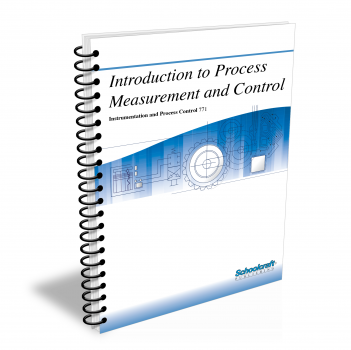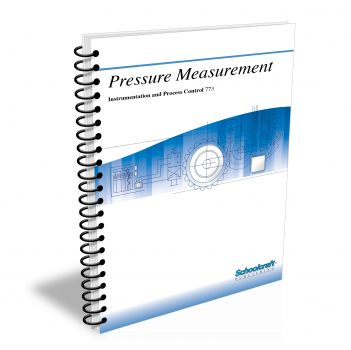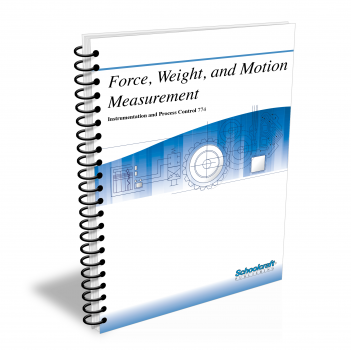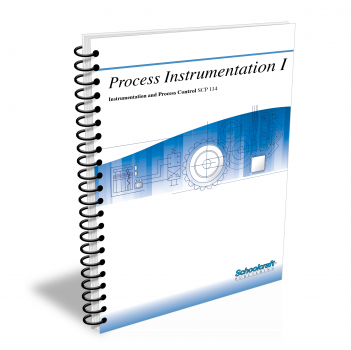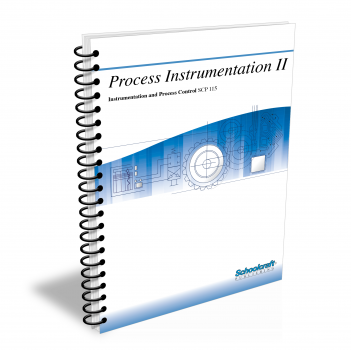Introduction to Instrumentation
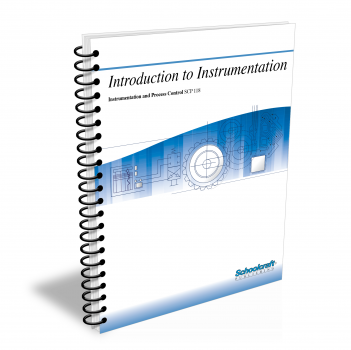
Course Number: 8118
The Introduction to Instrumentation textbook provides a thorough overview of instrumentation, and is suitable for students going on to careers in food processing and related industries. It is also suitable as a general introduction or first course in instrumentation—covers process control and signals, the foundations of measurement instrumentation, and temperature and pressure measurement.
Does your curriculum require additional topics not included in this textbook? Build a customized version of the Introduction to Instrumentation textbook below.
Recommended Contact Hours – 18
Preview a Chapter
Available Supporting Material
- Table of Contents
- Exam Copies
- Suggested Titles
Table of Contents
Chapter 1: The Nature of Process Control
Topics: Process variables; On-off control; Measuring data; Controlling variables, Error and feedback; Open- and closed-loop control
Learning Objectives:
- Define setpoint and error.
- Explain how measurement and control are related in industrial processes.
- Describe the four essential functions of an automatic control system.
- Discuss the functions of the CRT and PLC in control systems.
- Identify variables in industrial processes.
- Explain the importance of feedback in a closed-loop control system.
Chapter 2: Elements of Process Control
Topics: Analog and digital control signals; ASCII; Measuring pressure, level, and flow rate; Digital pulse control; System terminology; Controller action
Learning Objectives:
- Discuss the differences between modern automatic control systems and older ones.
- Identify the standard signals used in process control.
- Define the terms commonly used in control terminology.
- Explain the differences between open-loop control and closed-loop control.
- Describe on-off, proportional, integral, derivative, and PID controller action.
Chapter 3: Process Control Signals
Topics: Linear and nonlinear transducers; Signal operating values; Error; Controller output; Pneumatic and electrical signal transmission; Control loops
Learning Objectives:
- Discuss standard signals and linearity and explain how to calculate the value of a variable from an instrument's span and range.
- Describe five common sources of error in signal measurement.
- Discuss the basic principles governing pneumatic signal transmission and explain how a flapper-nozzle device works.
- Describe the function of the controller in a control loop.
- Discuss the basic principles governing electrical signal transmission, including Ohm's law, and list standard current and voltage signals.
- Explain the function of I/P devices in a typical control system and discuss the use of digital signals and optical signals.
Chapter 4: Principles of Pressure in Liquids and Gases
Topics: Properties of matter; Units of pressure; Density; Specific gravity, Gauge, absolute, and atmospheric pressure; Pressure and flow
Learning Objectives:
- Compare the three forms of matter.
- Define pressure and explain the difference between gauge pressure and absolute pressure.
- Discuss the conditions that affect the pressure of a liquid.
- Describe how changes in volume affect the pressure of a gas at a constant temperature.
- Describe how changes in temperature affect the volume of a gas at constant pressure, and the pressure of a gas with a constant volume.
- Discuss the two causes of pressure drop in a pipe carrying liquid from a tank.
Chapter 5: Pressure Sensors
Topics: Manometers; Bourdon tubes; Diaphragm sensor construction and capsule elements; Bellows sensors; Maintaining accuracy; Calibration
Learning Objectives:
- Explain how a manometer works.
- Describe four kinds of bourdon-tube sensors.
- Discuss construction details of bourdon tubes, diaphragms, and bellows.
- Explain how bellows pressure sensors work.
- Describe how calibration may be accomplished and list the steps in calibrating a pressure gauge.
- Explain how normally open and normally closed pressure switches work.
Chapter 6: Properties of Fluid Flow
Topics: Fluids in motion; Establishing a pressure difference; Indicating flow; Factors affecting flow rate; Reynolds number
Learning Objectives:
- Explain the difference between density and relative density (specific gravity).
- Define fluid velocity, viscosity, and volume flow rate.
- Describe laminar flow and turbulent flow.
- Explain how static head, friction head, and velocity head differ from each other.
- Explain how pipe size, pipe friction, and fluid viscosity affect the measurement of fluid flow.
Chapter 7: Primary Measuring Devices
Topics: Flow measurement in filled pipes; Restricting flow; Pressure drop; Orifice plates; Flow nozzles; Turndown and rangeability; Pipe taps
Learning Objectives:
- Describe direct and indirect flow measurement methods.
- Describe how a primary device creates a differential pressure.
- Give at least three examples of common primary devices and explain how each works.
- Describe the significant features of orifice plates and explain their functions.
- Discuss the conditions that determine the length of straight pipe required for each kind of primary flowmeter.
Chapter 8: Principles of Level Measurement
Topics: Surface-sensing and storage tank gauges; Sight glasses; Magnetic and displacer gauges; Buoyancy; Level, mercury, and magnetic reed switches; Switches with multiple displacers
Learning Objectives:
- Define datum point, and contrast direct and indirect level measurement.
- Describe the main kinds of surface-sensing gauges.
- Define buoyant force and explain how it is used in displacer gauges to measure liquid level.
- Describe maintenance procedures for float devices, displacer gauges, and sight glasses.
- Compare the use of sight glasses, mercury level switches, and magnetic reed switches.
Chapter 9: Electrical Instruments
Topics: Conductivity and liquid level; Capacitance probes; Zero and span adjustments; Ultrasonic, resistance, and photoelectric level detectors
Learning Objectives:
- Differentiate between continuous and point level measurements, and between direct and indirect level measurement.
- Describe the operation of a conductance probe in a conducting liquid.
- Describe the operation of a capacitance probe in a dielectric liquid.
- Explain the operation of ultrasonic, resistance, and photoelectric level sensors.
- Describe conductance point level probes, capacitance point level probes, and ultrasonic point level detectors.
Chapter 10: Temperature Measurement Principles and Indicators
Topics: Temperature and temperature scales; Heat; Change of state; Measuring instruments; Color change and melting point indicators
Learning Objectives:
- Define thermal energy and explain the relationships among thermal energy, heat, and temperature in a substance.
- Correlate changes in temperature with changes in a substance's physical state.
- Compare four temperature scales, and convert temperature readings from one scale to another.
- Explain how primary and secondary temperature calibration standards are used.
- Describe various temperature-measuring devices and contrast thermometers and pyrometers.
Chapter 11: Bimetallic and Fluid-Filled Temperature Instruments
Topics: Bimetallic, liquid-in-glass, and filled-system thermometers; Liquid- and gas-filled systems; Vapor-pressure systems; Capillary and bourdon tubes; Temperature transmitters
Learning Objectives:
- Discuss the physical characteristics and operation of bimetallic thermometers.
- Describe how liquid-in-glass thermometers are constructed and how they operate.
- Compare liquid-, gas-, and vapor-filled systems and discuss their advantages and disadvantages.
- Explain how a mercury thermometer operates.
Chapter 12: Fundamentals of Control Loops
Topics: Definitions; Process sensors; Sensor characteristics; Controllers; Recorders; Signal conditioners; Final control elements
Learning Objectives:
- Explain the difference between an open loop and a closed loop.
- Define error, feedback, disturbance, and feedforward control.
- List several kinds of process sensors and describe the operation of each.
- Explain how accuracy, resolution, sensitivity, linearity, and step response affect sensor operation.
- Describe the functions of process controllers, recorders, signal conditioners, and final control elements.
- Explain the basic operation of a typical control loop.
Request Exam Copies
Exam Copies
Ready to see a copy of our textbooks? After selecting which textbooks you’d like to review for your course, you can submit your request by either logging in or creating an account so we know where to ship your exam copies. A representative from Schoolcraft will contact you to confirm and finish processing your request.
Exam copies are always free and yours to keep.
Selected Exam Copies
none selected
* Maximum of five copies can be ordered
